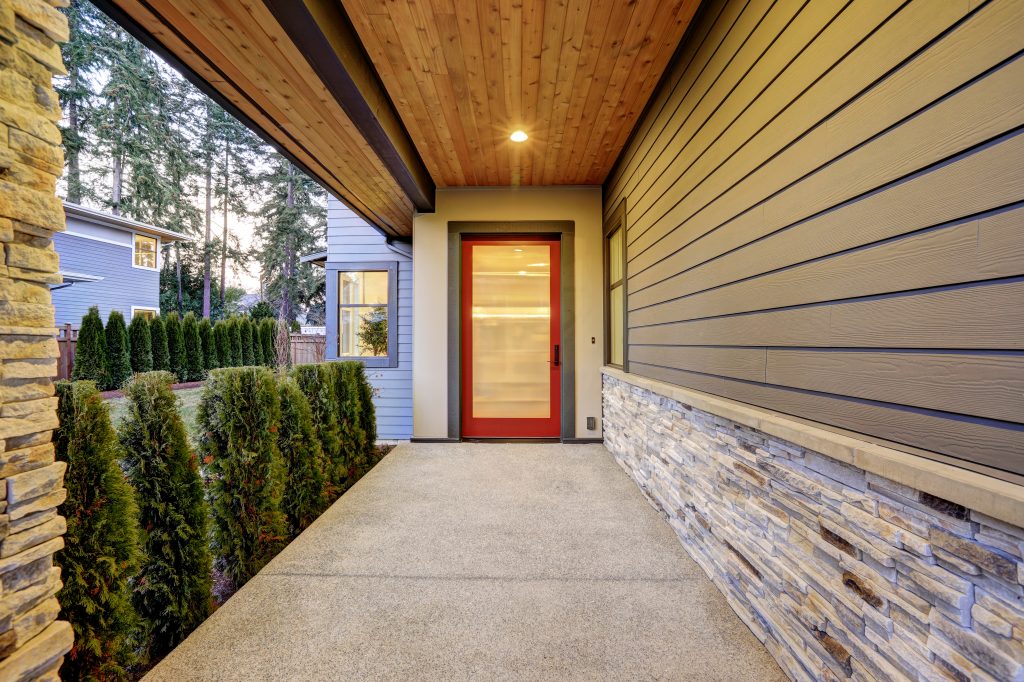
Safe, hard-surface, and covered approach to a home by incorporating aging in place design principles
The month of September is designated as Falls Prevention Month and we have talked a few times about falls and home safety as a part of this emphasis. As the month draws to a close, we don’t want to forget about home safety and keeping people from falling, but one strategy may help us as we go forward to implement home safety without actually mentioning to our clients what we are doing.
Of course, people want to remain safe in their homes, but they may not want to hear about avoiding falls or the potential for accidental or unintentional injury in their home. Instead of this type of approach, we still can eliminate many of the challenges to mobility in their home but stress that we want to help them have more freedom of movement rather than focusing just on the safety issue.
Starting at the doorway to their home, we want people to be able to get in freely without any challenges – even if they or any of the people who come calling on them are using an assistive device such as a walker, wheelchair, crutches, or a cane. Then we want them to be able to maneuver through the home and be capable of reaching and using all of the functional aspects of the home.
We can incorporate universal design aspects of the home layout because it means that anything in the home can be reached and used by anyone in the home regardless of their physical size, strength, or ability, and this would apply equally well to those living in the home full-time, visitors coming for an extended stay, and friends or neighbors stopping by for a briefer visit.
Good access, in addition to getting into a home safely and easily, means having the freedom of movement within a home – whether using a mobility aid or not, and whether limited vision, balance issues, or other factors are involved, to be able to move about as they desire and to use the various parts of the home without interference or hindrance from anything relating to the design or layout of that living space.
Essentially, someone should be able to open a window, go from room-to-room, set the thermostat, turn on or off light switches or ceiling fans, retrieve items from the pantry or cabinet, go into any room they desire, move about inside that room, prepare something to eat, use the bathroom and shower, reach frequently used items on cabinet or pantry shelves, open drawers, see themselves in mirrors, and generally function independently in that home – to the extent that their physical or sensory ability allows them to do this.
Many homes come up short in providing this type of access, but this is necessary for effective living in our homes and the reason we are looking at it as a way of promoting home safety and fall prevention.
Tripping over objects, stepping on them, or negotiating one’s way around items in the yard or on the walkway definitely affects access because it forms a barrier – from subtle to severe depending on what is involved. Sometimes, it the things that otherwise look like they fit that cause the issues – sand, gravel, weeds or grass growing into the walkway, small fallen branches or leaves, and sprinklers in use are such examples.
Safety is a part of accessibility that we can accommodate in our design without ever mentioning it to our clients. We can allow them to have a safe way to move about freely within their home and in the space outside their home in their yard, sidewalks, patios, porches, decks, and driveways. Comfort and convenience also factor into accessibility and safety concerns – giving us our four major precepts of aging in place design focus – because we are talking about creating spaces for our clients to use and move about within – inside their home and in the yard around their home – that are not challenging for them. They should not need to be especially cautious or give it any special thought – just use the spaces/
For instance, having a clear pathway and one that provides a solid, level, non-slippery footing – that does not present any obstacles that might interfere with walking or mobility – is a safe way to approach a home. This is true regardless of weather conditions or time of day – or someone’s general walking ability. Then once inside their home, they should have the ability and freedom to go to any part of the home and use any aspect of it without being confined or restricted in any way. This is true freedom of movement – to the extent that their personal mobility allows them range of motion, reach, and general mobility.
